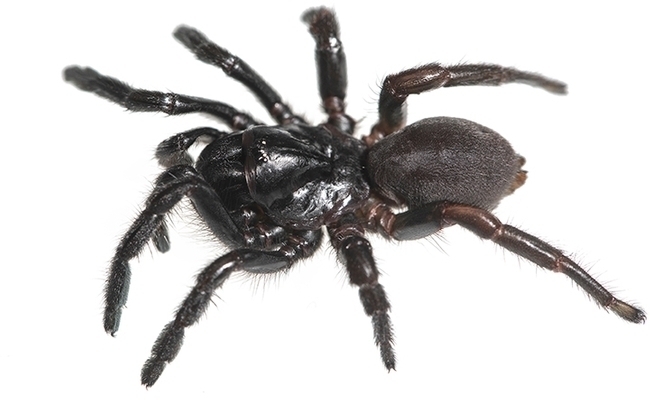- Author: Kathy Keatley Garvey
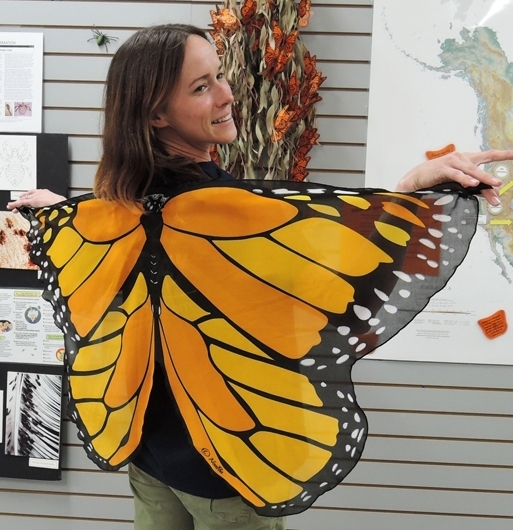
The work of entomologist Christine Melvin, a graduate of UC Davis, the banner features a hover fly, sphecid wasp, snakefly, bumble bee, aphid, twisted wing parasite and a tardigrade (water bear).
Melvin's artist statement: "It was a pleasure to create an image in honor of the 75th anniversary for the Bohart Museum of Entomology. I spent countless hours at the museum as an undergraduate student and learned so much from so many people who all shared a love for entomology. I wanted the image to include a diverse group of insects, a few California native plants and a banner; all in a heart shape of sorts. The bleeding heart flowers on the left are being visited by a hover fly from the order Diptera. The California poppies on the right have a thread-waisted wasp from the order Hymenoptera on top. On the stem of one of the poppies is an aphid from the order Hemiptera that is being hunted by a snakefly (far right) from the order Neuroptera. In the center of the image, flax flowers are being visited by Franklin's bumble bee, from the order Hymenoptera, in honor of the late Dr. Robbin Thorp. At the bottom right is a tardigrade, which visitors will find a statue of outside the museum building. Finally on the lower left-hand side is a twisted-winged parasite, from the order Strepsiptera, in honor of Dr. Bohart himself."
The Bohart Museum's tardigrade collection includes some 25,000 slide-mounted specimens. It ties in with the 2,112-pound tardigrade sculpture, created by artist Solomon Bassoff of Nevada County, that graces the entrance to the Bohart Museum.
Melvin, who received her degree in the spring of 2017 and moved to the Big Island in July 2019, is on track to receive her master's degree in entomology (distance-learning) through the University of Nebraska-Lincoln.
"Shortly after moving here, the pandemic began which allowed me a rare chance of living in Hawaii when there were no tourists; I am truly grateful for that experience," she related. "The down-time from the pandemic has also allowed me to really focus on my MS degree which will be complete in the spring of 2022."
For her master's project, she will create an illustrated guide to the butterflies of Northern Yosemite with a heavy emphasis on life history and citizen science. "I am still working on the title," Melvin said. "The courses taken to complete my MS degree included specialized and general entomology, scientific illustration and science communication. It is my goal to make this the first of many entomology focused and illustrated publications to encourage and honor citizen science."
"I will be returning to the mainland in January of 2022 because as much as I love Hawaii, there are more insects on the mainland and I miss them!"
Bohart Museum and Director Toasted. Rain dampened the Crocker Lane event but not the enthusiasm as the crowd toasted the work of the Bohart Museum and its director Lynn Kimsey, UC Davis distinguished professor of entomology.
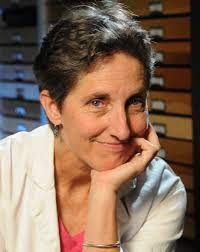
“We should take a moment to not only express our appreciation of the Bohart Museum and the legacy that Dr. Richard Bohart left, but to all the work Lynn has done to make events like this possible and to continue the important work,” emcee Jason Bond, the Evert and Marion Schlinger Endowed Chair and professor, UC Davis Department of Entomology and Nematology, told the crowd.
Bond, who was named Associate Dean for Research and Outreach for Agricultural Sciences, the College of Agricultural and Environmental Sciences on Oct. 25, said museum collections have “tremendous educational value and they also have amazing research value as well.”
CrowdFund Project. Bond urged the crowd to help support the outreach mission of the museum. Bohart Museum scientists are seeking donations for their traveling insect specimen displays. They aim to raise $5000 by 11:59 p.m., Oct. 31 for their UC Davis CrowdFund project to purchase traveling display boxes for their specimens, which include bees, butterflies and beetles. These are portable glass-topped display boxes that travel throughout Northern California to school classrooms, youth group meetings, festivals, events, museums, hospitals--and more--to help people learn about the exciting world of insect science.
“When COVID halted our in-person outreach programs, we were still able to safely loan these educational materials to teachers,” said Tabatha Yang, the Bohart Museum's education and outreach coordinator. “Now that UC Davis is open again to students we have all these bright, students on campus with fresh and diverse perspectives. We want to support their talent, so the funds we are raising will go to students for the creation of new traveling displays. This fleet of new educational drawers will expand and update what we can offer. Some of our current displays were created 15 years ago! One can only imagine all the places these drawers have been and all the people who have been inspired."
Donors can do so in memory of someone, a place, or a favorite insect. Bond donated $500 in honor of Lynn Kimsey. The donation page and map are at https://bit.ly/3v4MoaJ
The Bohart Museum, currently closed to the public due to COVID-19 precautions, is located in Room 1124 of the Academic Surge Building on Crocker Lane. In addition to its insect collection, the seventh largest in North America, it houses a live “petting zoo,” comprised of Madagascar hissing cockroaches, stick insects and tarantulas, and a gift shop (now online), stocked with insect-themed t-shirts, hoodies, jewelry, books, posters and other items. Further information is on the website at https://bohart.ucdavis.edu.



- Author: Kathy Keatley Garvey
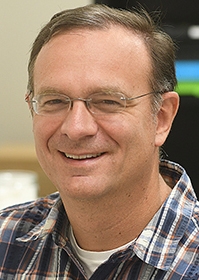
The multi-talented professor, researcher, teacher and editor--with a deep background in administration--is the newly appointed Associate Dean for Research and Outreach for Agricultural Sciences, UC Davis College of Agricultural and Environmental Sciences.
"Jason's position is effective today, Oct 25," announced Dean Helene Dillard. "Jason succeeds Anita Oberbauer, who was reappointed earlier this summer as executive associate dean for the college."
"He has a long history at land-grant institutions, beginning with his Ph.D. in evolutionary systematics and genetics at Virginia Tech and later as a postdoctoral researcher at the Field Museum of Natural History in Chicago," she related.
In an email to fellow members of his department today, Bond wrote: "Like everyone, the events over the last year and half related to the pandemic, like how we communicate science, global change, and the massive social problems these issues are revealing, have really left an impression on me, and consequently feeling like I should be doing more. I have been impressed with Dean Dillard and the group that she has advising her, and am really excited about the opportunity to help facilitate the research, outreach, and DEI (Diversity, Equity, and Inclusion) missions of the College in a meaningful way."
Bond added that he has "no intention of abandoning my research/systematics program, teaching, or other Departmental obligations." He noted that he and his wife, Kristen (who coordinates a nurse training program for Dignity Health) graduated their only daughter this past June from Davis High School and "we are now empty nesters."
Professor Bond joined the UC Davis faculty in 2018 from Auburn University, where he directed the Auburn University Museum of Natural History (2011–2016), and served as professor and chair of the Auburn Department of Biological Sciences (2016–2018). He played a major role in the design and construction of a new state-of-the-art collections facility. He also directed the Alabama Natural Heritage Program, guiding its conservation activities of endangered and threatened species in the Southeast.
Bond was recently named co-editor-in-chief of the journal Insect Systematics and Diversity (ISD), published by the Entomological Society of America, and will serve a four-year term, starting Jan. 1. His credentials also include associate editor of Systematic Biology (2019–present) and editor of New World Mygalomorphae for Zootaxa (2016–present).
In his research, Bond specializes in the evolutionary diversification of terrestrial arthropods, specifically spiders, millipedes, and tenebrionid beetles; and researches the landscape scale genomics of California species, with an emphasis on understanding the impact of global change on biodiversity. (See Bond laboratory.) He is also a principal investigator associated with the California Conservation Genomics Project, a state-funded initiative with a single goal: to produce the most comprehensive, multispecies, genomic dataset ever assembled to help manage regional biodiversity.
Born in Johnson City, Tenn., Jason spent his childhood in Lewisville, N.C., a small town just outside of Winston-Salem. His American roots run deep; his ancestors made munitions for George Washington's army. His father grew up on the campus of East Tennessee State University, where his grandfather served as head of facilities. “The Bond Building” bears his name.
Jason received his bachelor's degree in biological sciences, cum laude, in 1993 from Western Carolina University, Cullowhee, and his master's degree in biology in 1995 from Virginia Polytechnic Institute and State University, Blacksburg. He earned his doctorate in evolutionary systematics and genetics in 1999 from Virginia Tech.
A veteran of the U.S. Army, Bond served for a number of years as a UH-60 Blackhawk helicopter crew chief.
- Author: Kathy Keatley Garvey
Gotta love those spiders.
We recently saw an adorable jumping spider (aren't all jumping spiders adorable?) huddled or cuddled (your preference) within a layer of yellow rose petals. It didn't look like a poster child for Halloween. It looked right at home.
It's still there.
In a March 2019 Bug Squad blog, we posted five good reasons to like spiders, compliments of Professor Jason Bond of the UC Davis Department of Entomology and Nematology. He's the Evert and Marion Schlinger Endowed Chair in Insect Systematics in the UC Davis Department of Entomology and Nematology and a newly selected co-editor-in-chief of the journal Insect Systematics and Diversity (ISD), published by the Entomological Society of America (ESA).
“Spiders have been around for 400 million years and are cunning, skillful predators," Professor Bond says. They are "an incredibly diverse group with more than 50,000 species described with probably another 200,000 remaining to yet be discovered."
The five good reasons to like spiders?
- Spiders consume 400-800 million tons of prey, mostly insects, each year. Humans consume somewhere around 400 million tons of meat and fish each year.
- Spider silk is one of the strongest naturally occurring materials. Spider silk is stronger than steel, stronger and more stretchy than Kevlar; a pencil thick strand of spider silk could be used to stop a Boeing 747 in flight.
- Some spiders are incredibly fast – able to run up to 70 body lengths per second (10X faster than Usain Bolt).
- Although nearly all 47,000-plus spider species have venom used to kill their insect prey, very few actually have venom that is harmful to humans.
- Some spiders are really good parents –wolf spider moms carry their young on their backs until they are ready to strike out on their own; female trapdoor spiders keep their broods safe inside their burrows often longer than one year, and some female jumping spiders even nurse their spiderlings with a protein rich substance comparable to milk.
When Professor Bond spoke at the Bohart Museum of Entomology open house, “Eight-Legged Wonders,” on March 9, 2019, showcasing spiders, he drew scores of questions. Following his talk, the visitors participated in interactive activities, including “How to Eat Like a Spider,” “How to Assemble an Arachnid,” "How to Catch a Moth," "Create a Chelicerate" and others. So educational and entertaining and let's hope another one will be on the calendar in the near future! The Bohart Museum, currently closed to the public due to COVID-19 precautions, is located in Room 1124 of the Academic Surge Building on Crocker Lane, UC Davis campus. It is the home of nearly 8 million insect specimens, and also a live "petting zoo" (think Madagascar hissing cockroaches, walking sticks and tarantulas) and an online insect-themed gift shop, stocked with t-shirts, hoodies, jewelry, posters, and collecting equipment.
Meanwhile, Herman or Hermanina, is basking in the sun, getting ready to substantiate Professor Bond's excellent description: "a cunning, skillful predator."
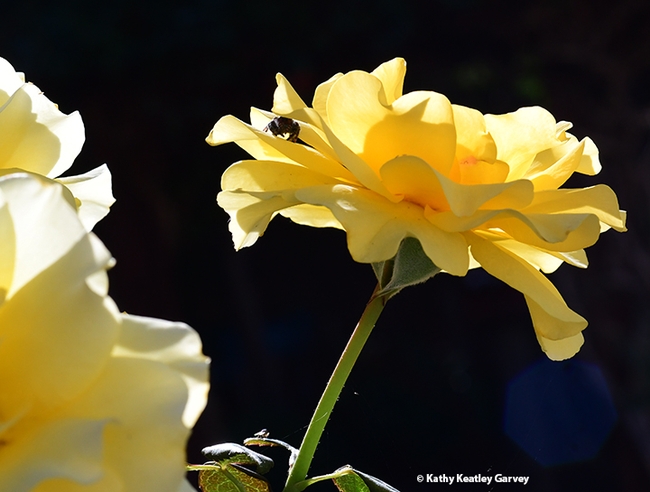
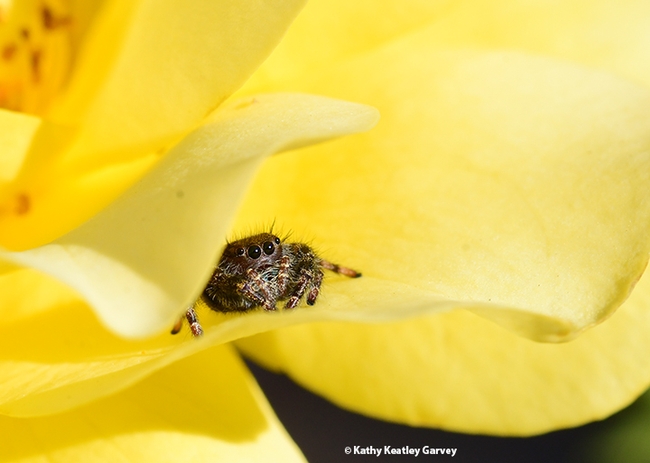
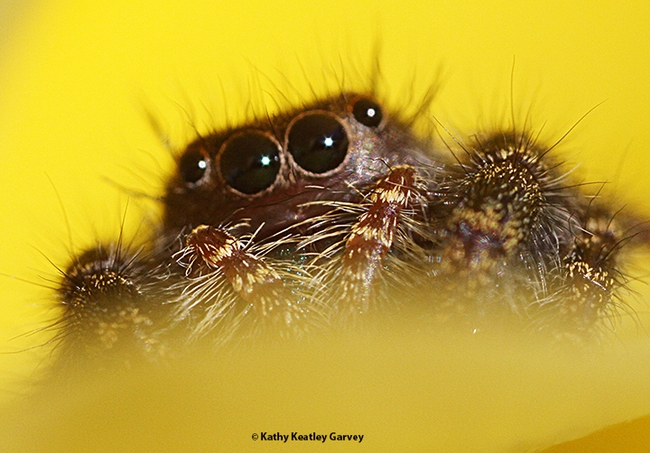
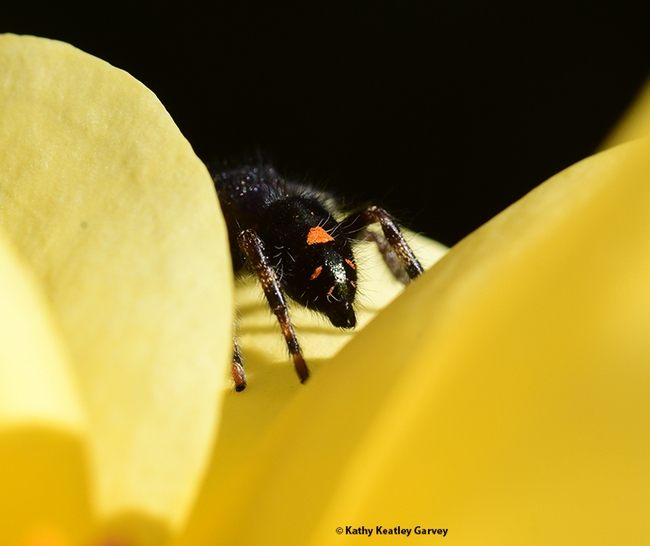
- Author: Kathy Keatley Garvey
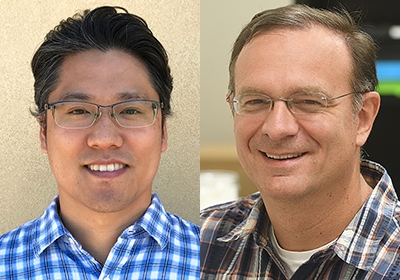
Jason Bond, UC Davis professor of entomology and the Evert and Marion Schlinger endowed chair in insect systematics is a newly selected co-editor-in-chief of the journal Insect Systematics and Diversity (ISD), published by the Entomological Society of America (ESA).
He and Hojun Song, an associate professor of entomology at Texas A&M University, will serve a four-year term, starting Jan. 1. They succeed founding editors Sydney Cameron and James Whitfield, both professors of entomology at the University of Illinois, Urbana.
ISD, launched in 2017, publishes research on systematics, evolution, and biodiversity of insects and related arthropods, including comparative and developmental morphology, conservation, behavior, taxonomy,molecular phylogenetics, paleobiology, natural history, and phylogeography. The journal is heralded for its cutting-edge research, according to an ESA news release issued Oct. 12.
"Dr. Song and Dr. Bond are esteemed leaders in their areas of research, and their knowledge and experience with the evolving techniques in systematics, evolution, genomics, and beyond make them ideal for this role," ESA President Michelle Smith said in the press release. "My fellow ESA Governing Board members and I are pleased to welcome them aboard, and we look forward to seeing them build upon the excellent foundation that Dr. Cameron and Dr. Whitfield have established."
ESA vice president Jessica Ware, who chaired the search committee, praised Bond and Song for their "experience and enthusiasm" for advancing the journal. "They both impressed the committee with their editorial skill, scientific expertise, and commitment to ESA's mission and vision for its family of journals. ISD aims to publish high-impact, integrative research, and I'm confident the journal will be in good hands." (See news release.)
Jason Bond. Bond joined the UC Davis Department of Entomology and Nematology faculty in 2018 from Auburn University, Alabama, where he directed the Auburn University Museum of Natural History (2011–2016), and served as professor and chair of the Auburn Department of Biological Sciences (2016–2018). He specializes in the evolutionary diversification of terrestrial arthropods, specifically spiders, millipedes, and tenebrionid beetles. (See Bond laboratory.)
Bond holds a bachelor's degree in biology (1993) from Western Carolina University, and two degrees from Virginia Tech: a master's degree in biology (1995) and a doctorate in evolutionary systematics (1999). He began his career as a research associate at the Field Museum of Natural History in Chicago in 1990. His credentials include associate editor of Systematic Biology (2019–present) and editor of New World Mygalomorphae for Zootaxa (2016–present).
Hojun Song. Song holds three degrees in entomology: a bachelor's degree (2000) from Cornell University and both his master's (2002) and doctorate (2006) from Ohio State University. He began his career as a research fellow in 2006 at Brigham Young University, and then served as an assistant professor and curator of the Stuart M. Fullerton Collection of Arthropods, University of Central Florida, before joining the Texas A&M faculty in 2015. He was named editor-in-chief of the journal Insect Systematics and Evolution in 2014. He specializes in arthropod systematics, biodiversity and evolution. (See Song laboratory.)
"I am honored to be selected as a new co-editor-in-chief of Insect Systematics and Diversity, and I am excited about the possibility of moving the field of insect systematics in this new capacity," Song told ESA. "The inaugural co-editors-in-chief, Drs. Sydney Cameron and Jim Whitfield, have done a tremendous job launching the journal. Dr. Bond and I have some big shoes to fill, but we will do our best to make sure that ISD continues to become an outlet for publishing the best work in insect systematics, evolution, and biodiversity."
A tip of the insect net to the new co-editors-in-chief!
UC Davis Resources:
- Spotlight on Jason Bond (UC Davis Department of Entomology and Nematology)
- A Spider Is Always Watching You! (Bohart Museum of Entomology Open House)
- Name That Spider: Meet Cryptocteniza kawtak (UC Davis Department of Entomology and Nematology)
ESA
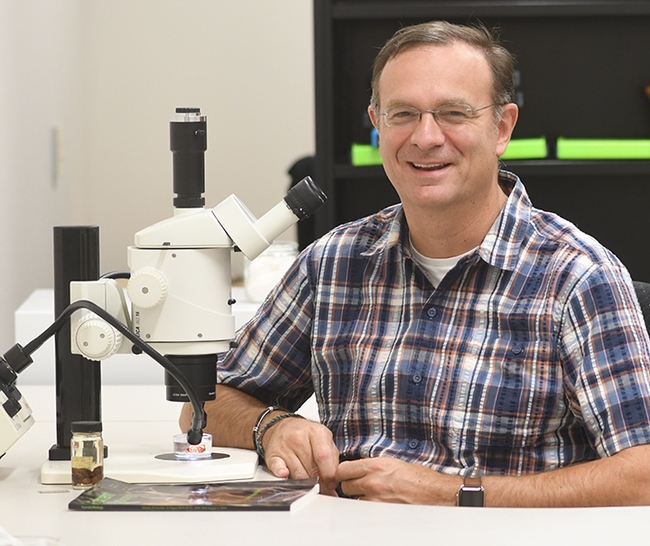
- Author: Kathy Keatley Garvey
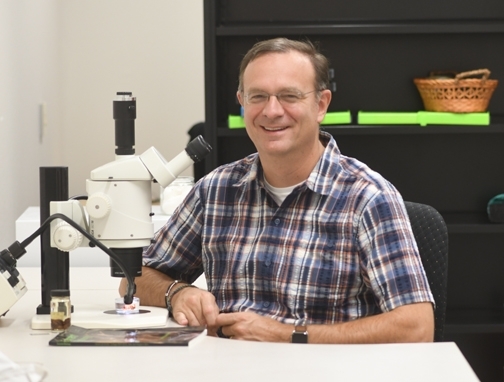
- Shouldn't we be paying more attention to the undiscovered life on this planet while we're exploring other planets for signs of life?
- Shouldn't taxonomy be more valued, appreciated and funded? Shouldn't we be offering more encouragement and training to our students?
Yes, says Jason Bond, the Evert and Marion Schlinger Endowed Chair in Insect Systematics, UC Davis Department of Entomology and Nematology.
The recent podcast, by New Species host L. Brian Patrick, professor of biology at Dakota Wesleyan University, covered the “Taxonomic Impediment." The link:
Bond, who joined the UC Davis faculty in 2018 from Auburn University, Alabama, where he directed the Auburn University Museum of Natural History and chaired the Department of Biological Sciences, focuses his research “primarily on the discovery, conservation, and investigation of the pattern and processes responsible for the diversity of life.”
“My research program has been principally aimed to 1) document biodiversity by discovering and describing new species (and higher taxa, genera and families), 2) identify various dimensions of diversity and those underlying evolutionary processes that generate it, and 3) use these findings to identify threatened or endangered populations and taxa,” he writes on his website. “My organismal expertise centers on terrestrial arthropods (spiders, millipedes, and tenebrionid beetles). Current research projects focus on spider and beetle speciation pattern and process, higher level phylogenomics of millipedes and spiders, and understanding broad-scale patterns of biodiversity and relationship to biogeography, habitat destruction, and climate (contemporary and historical).”
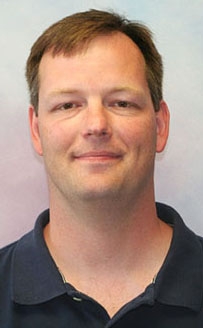
“Typically I think the traditional definition of taxonomy is ‘the science of describing and classifying species,'” Bond told us following the podcast. “I think this definition typically misrepresents taxonomy as a purely descriptive science, which it is not. I think taxonomy might be better defined as ‘the science of species delimitation and classification.' Modern taxonomic species are the outcome of an experiment that tests integrative (i.e., using morphological, genetic, ecological, physiological, etc. ) hypotheses of homology, variation and evolutionary relatedness. These species are serve as hypotheses subject to further testing and refinement as more data (e.g., specimens, genomic, etc.) become available.”
Patrick launched the podcast by describing Bond as “one of my hero arachnologists.”
Bond began by calling attention to the “massive number” of undescribed species in the world. For example, there are about 50,000 described species of spiders, he said, but there are “probably 10 times more than that.” Scores of undescribed species are shelved in insect museums.
When Patrick asked him why there's a taxonomic impediment, Bond commented that “most fundamentally, it's hard work,” and that “very few people are being trained as taxonomists” and very few are hiring them. “If you're a taxonomist working on an obscure group,” you may be the first to be cut from your position, he said.
Bond declared there's a big difference between “identifying arthropods and the science of taxonomy. Someone did the underlying science to allow a person to make that identification.”
“What we're talking about is evolutionary biology,” Bond explained. “We seldom see ads at big universities advertising for a spider taxonomist or a mayfly taxonomist. They want evolutionary biologists. As we train students, we should train them as taxonomists who can clearly sell themselves as evolutionary biologists.”
The National Science Foundation (NSF) used to train students in taxonomy in its PEET (Partnerships for Enhancing Expertise in Taxonomy) program. But PEET is now longer accepting grant proposals.
DNA barcoding, or a method of species identification using a short section of DNA from a specific gene or genes, “is useless in a vacuum,” Bond related. “Someone has to the initial work.”
“If we visited another planet,” Bond said, “and discovered new forms of life, it would be nearly impossible to apply DNA barcoding…there is no silver magic bullet out there to automate species discovery and classification.”
When asked how he would resolve taxonomic impediment, Bond related that more exposure and more funding would certainly help. “We spent $2.9 billion on the Perseverance Mars probe,” Bond said, but in comparison, the annual budget of the NSF's Division of Environmental Biology (which includes grants for taxonomists) amounts to about $155 million. “We spend massive amounts of money exploring other planets than the planet we are on.”
“We're ignoring species extinctions in our own back yard,” Patrick added.
Bond agreed. “While we're trying to find intelligent life on other planets, we are destroying some of the life on our own,” the UC Davis professor said, adding that the next frontier--space exploration—always seems to be more exciting than what we have here.
Bond, who has described more than 100 new taxa--families, genera, species of spiders and millipedes--advocates more attention to taxonomy to “generate the enthusiasm that's out there. We need a hero.”
“If I were independently wealthy, I'd establish a taxonomic foundation or institute where we hire taxonomists to work in-residence,” Bond said, adding that to move science forward, we should bring them in from all over world to work on their regional fauna; and give them the training they need--“at least five years to really work and develop a team.”
